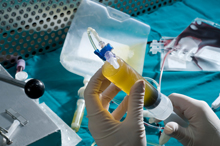Time for T cell renewal
Autologous hematopoietic stem cell transplantation (aHSCT) has shown great potential in subjects with multiple sclerosis (MS). Previous work showed a slow return of naïve T cells after aHSCT. However, the dynamics of new and surviving T cells after aHSCT remain to be elucidated. Here, Ruder et al. analyzed samples from patients with MS after aHSCT and showed that whereas effector memory T cells quickly reconstitute, naïve T cells show a slower complete renewal. In addition, the authors performed a complete characterization of the renewed T cell population. The results will provide a valuable resource for understanding the mechanisms mediating the efficacy of aHSCT in patients with MS.
Abstract
Autologous hematopoietic stem cell transplantation (aHSCT) is a highly effective treatment of multiple sclerosis (MS). It depletes autoreactive cells and subsequently renews adaptive immune cells. The possible proinflammatory potential of surviving T cells early after aHSCT has not been studied. Here, we examined the dynamics of new and surviving T cells in 27 patients after aHSCT by multidimensional flow cytometry, T cell receptor (TCR) sequencing, specificity testing, telomere length profiling, and HLA genotyping. Early after aHSCT, naïve T cells are barely detectable, whereas effector memory (EM) T cells quickly reconstitute to pre-aHSCT values. EM CD4+ T cells early after aHSCT have shorter telomeres, have higher expression of senescence and exhaustion markers, and proliferate less than those before aHSCT. We find a median TCR repertoire overlap of 26% between the early post-aHSCT EM CD4+ T cells and pre-aHSCT, indicating persistence of EM CD4+ T cells early after transplantation. The EM CD4+ TCR repertoire overlap declines to 15% at 12 months after aHSCT, whereas the naïve TCR repertoire entirely renews. HLA-DR–associated EM CD4+ T cell reactivity toward MS-related antigens decreased after aHSCT, whereas reactivity toward EBV increased. Our data show substantial survival of pre-aHSCT EM CD4+ T cells early after transplantation but complete renewal of the T cell repertoire by nascent T cells later.







